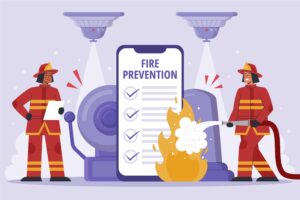
Fire safety is one of the most important concerns for all businesses, owners, and institutions. This will be continuously assessed for keeping safe environments as well as compliance with the rules. The two most general types of assessments, Fire Safety Audits, and Fire Inspections are at times confused with each other. These have different purposes and benefits. Awareness on the differences between these two services will help organizations and property owners determine whether the fire safety systems or compliance with law will need to be upgraded.
A Fire Safety Audit is an in-depth assessment of a building’s fire safety policies, infrastructure, and compliance with the standards set by the law. It is conducted by auditors who are qualified and trained in this regard. It is a thorough assessment of potential risks, safety practices, and preparedness for emergencies. The main objective of Fire Safety Audits is to assess the fire hazards and suggest improvements along with recommendations to increase overall fire resilience.
A Fire Safety Audit usually entails a detailed analysis of:
At the end, Fire Safety Audits provide a detailed report on risk and areas for improvement and what actions should be taken. An audit is different from regular inspections, which mainly observe current conditions, but it helps in giving a long-term safety strategy and assists in putting up comprehensive fire prevention plans.
Also Read: Comprehensive Guide to Fire Safety Audits
The fire department officer or a certified inspector does fire inspections regarding ensuring a building is conformed to current fire safety provisions. In addition, fire safety equipment as well as the exit way of the facility must be operating and accessible to ensure the place meets minimum standards to be in operation. Many businesses, educational institutes, health care facilities, and other public buildings require a regular inspection.
During a fire inspection, the inspector will check:
Fire inspections are usually annually scheduled or as a consequence of specific events, which may include building construction, renovation, or complaints. This usually results in prompt recommendation or citation if any problems arise, and corrective action is thus expected to occur shortly afterward.
Although fire safety audits and fire inspections are integral parts in preventing fires, keeping individuals safe, they differ quite a lot when it comes to scope, purposes, and frequency. The main differences include:
Effective management of fire risks requires two prime tools: Fire Safety Audits and Fire Inspections. Together, these inspections help create a more rigid framework of fire safety within an organization, reduce possible fire risks, provide proof of legal compliance, and protect lives and assets in the process.
Every organization should schedule Fire Safety Audits periodically, especially after radical changes in the building, its use, or occupant. In risky and high-risk industries such as chemical processing, healthcare or educational institutions, audits must take place annually. Fire Inspection Scheduling is generally in tune with local regulations, and in some cases, frequent inspections are done in any high-occupancy risk facilities.
In summary, Fire Safety Audits and Fire Inspections are utilized for different purposes. The former is a detailed assessment, which serves as the foundation of a proactive approach to fire prevention, whereas the latter confirms legal compliance with the existence of safety operational systems and accessible routes out of a building. They complement each other and together form a layered approach toward fire safety, aiding in the protection of lives, preservation of assets, and avoidance of potential legal implications.
Businesses or institutions or property managers shall invest in both audits and inspections not only to gain compliance but also to set up a safe environment and offer protection to all. No one wants to be derailed in today’s fast-paced world where even safety standards and technologies continuously evolve. The only method to keep ahead of any fire risks is to advance operational continuity and occupant safety.